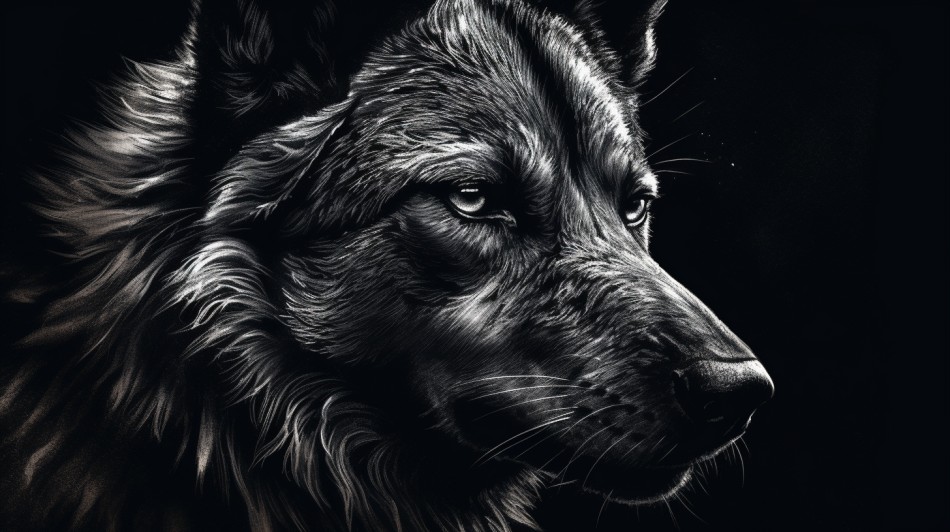Under cover of night, the weary party trudges through the dense woods, bearing the wounds of a hard-fought battle against a formidable foe. Their strength wanes, resources dwindle, and a glimmer of safety beckons from the nearby town. Yet, just as they start to believe they have escaped unscathed, haunting howls shatter the silence, and a colossal wolf emerges from the shadows.
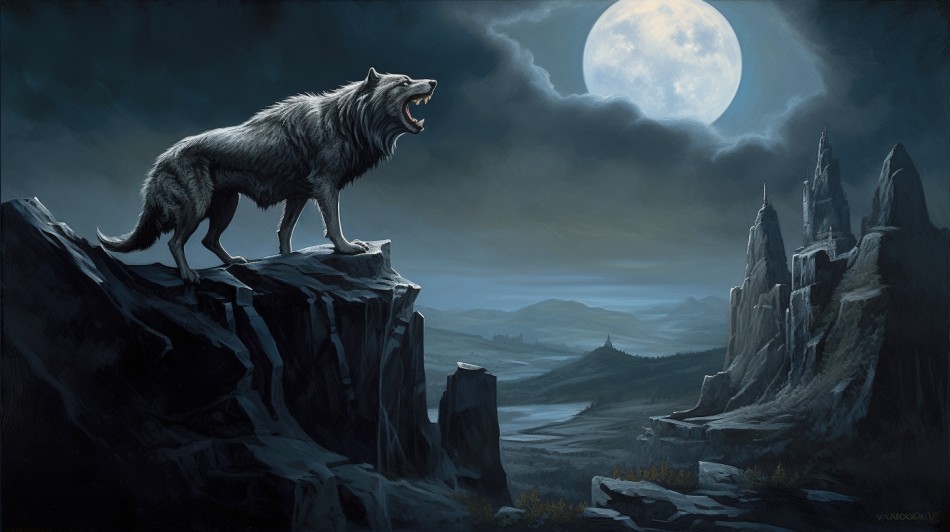
Brace yourselves, and prepare to roll initiative. These larger, more menacing creatures than their gray wolf counterparts should never be underestimated. They can incapacitate even the hardiest of adventurers with sheer size and ferocity. Prepare for the perilous encounter that lies ahead.
What makes the dire wolf so dangerous, you may ask? The inherent danger lies in their ubiquitous presence. Dire wolves can be found across various habitats, making them a constant threat. Overconfidence can prove fatal when facing these relentless predators.
The Dire Wolf

The Dire Wolf, an ancient variant of the grey wolf, stands as an imposing presence, surpassing the size of regular wolves. They command attention with an average length of around 9 feet and weighing approximately 800 pounds. These creatures can exhibit aggressive behavior and operate either solo or in packs alongside 3-5 other wolves. Possessing an Armor Class (AC) of 14, an average of 37 hit points, and a speed of 50 feet, Dire Wolves boast the following abilities:
- Keen Hearing and Smell: The wolf’s acute senses grant them an advantage in Wisdom (Perception) checks that rely on hearing or smell. They possess an uncanny ability to detect intruders who dare enter their territory.
- Pack Tactics: When fighting alongside at least one unincapacitated ally within 5 feet of the target, the Dire Wolf gains an advantage in attack rolls against that creature, showcasing their formidable pack tactics.
- Bite: Engaging in a melee weapon attack, the Dire Wolf employs its massive jaws with a +5 to hit. Within reach of 5 feet, it inflicts piercing damage of (2d6 + 3). Should the target be a creature, including humanoids, they must succeed in a DC 13 Strength saving throw to avoid being rendered unconscious by the powerful force of the wolf’s bite.
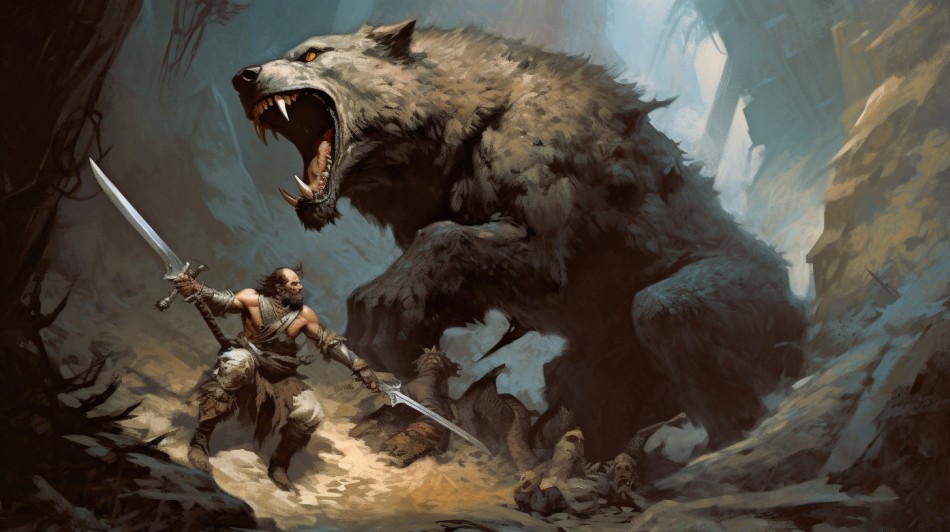
These characteristics underline the Dire Wolf’s acute sensory perception, making it adept at detecting intruders and coordinating attacks within a pack. While their bite may not possess immediate lethality, it can incapacitate creatures if their strength proves insufficient to resist the wolf’s crushing force.
Dire Wolf Tactics: Cunning Predators on the Prowl
When engaging a pack of three to five dire wolves, it is crucial to understand their strategic approach to combat. These intelligent and coordinated creatures work together to maximize their advantage and eliminate the weakest member of the targeted group. Their tactics encompass flanking, close coordination, powerful jaw strikes aimed at toppling their prey, and the relentless pursuit of advantageous positions. In addition, dire wolves employ hit-and-run maneuvers, utilizing their impressive speed to separate the party before launching subsequent attacks.
These cunning predators possess exceptional senses, often detecting or hearing party members long before they become visible. They exploit their stealth to approach and lay the groundwork for a devastating ambush.
If your party has been injured or bloodied in a prior encounter, dire wolves may become even more aggressive, perceiving weakness in their prey.
Dire wolves are driven by aggression and a relentless pursuit of their objective, unlike their counterparts who may solely fight for territory or sustenance. Once engaged in combat, they persist until the bitter end, showing no inclination to retreat. It’s important to note that, like regular wolves, dire wolves possess a keen sensitivity to blood and gore. If your party has been injured or bloodied in a prior encounter, dire wolves may become even more aggressive, perceiving weakness in their prey. They recognize that wounded targets are more vulnerable and represent a potential source of sustenance, increasing their determination to bring them down.
Understanding the tactical nature of dire wolves is essential when facing these skilled predators. Prepare for their flanking maneuvers, coordinated strikes, and relentless pursuit, as they exhibit a tenacity unmatched by their counterparts.
Strategies Against Dire Wolves
When faced with the ferocious threat of dire wolves, your players must devise effective strategies, whether combating them within a pack or facing them as leaders. These creatures’ running and striking tactics can prove daunting for melee-focused players. For heavily armored melee characters, creating a defensive formation and positioning themselves as a protective barrier around the group’s most vulnerable members can be highly effective. The melee players can buy valuable time and safeguard their allies by forcing the dire wolves to engage with them first.
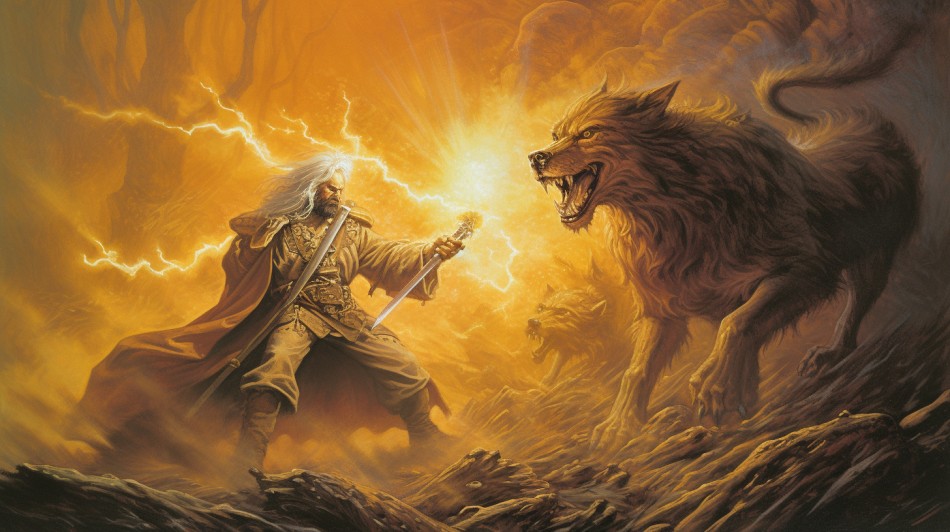
Magic-casting characters are advantaged in targeting dire wolves due to their comparatively lower Armor Class (AC). They can capitalize on this weakness by precisely aiming spells and attacks at these formidable creatures. Area-of-effect (AoE) spells can prove particularly useful in mitigating damage across the pack, reducing their collective threat. However, caution must be exercised to avoid retaliation from the dire wolves’ powerful bites, which can swiftly incapacitate targets. It’s worth noting that dire wolves are immune to damage resistance, making them vulnerable to all damage types. This opens up various options for players to employ various means to inflict harm.
Some Dungeon Masters introduce an additional layer of strategy by incorporating the natural fear of fire within the wolves’ behavior. In these cases, dire wolves may be subjected to a will-save or experience panic when confronted with fire spells, capitalizing on their instinctive aversion to the element.
By implementing these tactical approaches and leveraging the unique strengths of each party member, your players can increase their chances of subduing the savage beasts known as dire wolves.
How to Fight Packs of Wolves
While dire wolves are more inclined to fight as solitary hunters, circumstances can elevate them to the alpha position within a regular wolf pack. When fighting alongside weaker wolves, their tactics adapt accordingly. Wolf packs are constantly on the move, aiming to separate the party and exploit the vulnerabilities of the weakest member. Once engaged, the wolves swiftly rush in, seeking to bite their foes. A successful bite sets the stage for other wolves to capitalize on the pack’s coordinated tactics, positioning themselves strategically around the enemy.

Dire wolves behave similarly to their real-world counterparts, initially utilizing hunting instincts to evade confrontation. They entice the party by giving chase, leading them away from potential escape routes. After sating their appetite with a few bites, the true attack commences. The wolves converge in greater numbers, encircling the party while select individuals rush in to target the most vulnerable members.
They aim to gain the upper hand in the confrontation through coordinated pairs and strategic maneuvering. This relentless assault persists until the party is overcome or until a significant portion, roughly a quarter to half, has been injured or slain. If the wolves sustain injuries, they may choose to retreat.
Facing packs of wolves demands utmost caution and tactical prowess. Be prepared for their relentless pursuit, calculated strikes, and unwavering determination to overpower their adversaries.
Dire Wolf Variants
Introducing variant types of dire wolves can excite your party’s woodland travels. These unique specimens offer thrilling encounters that will leave a lasting impression on your players. Consider the following variants:
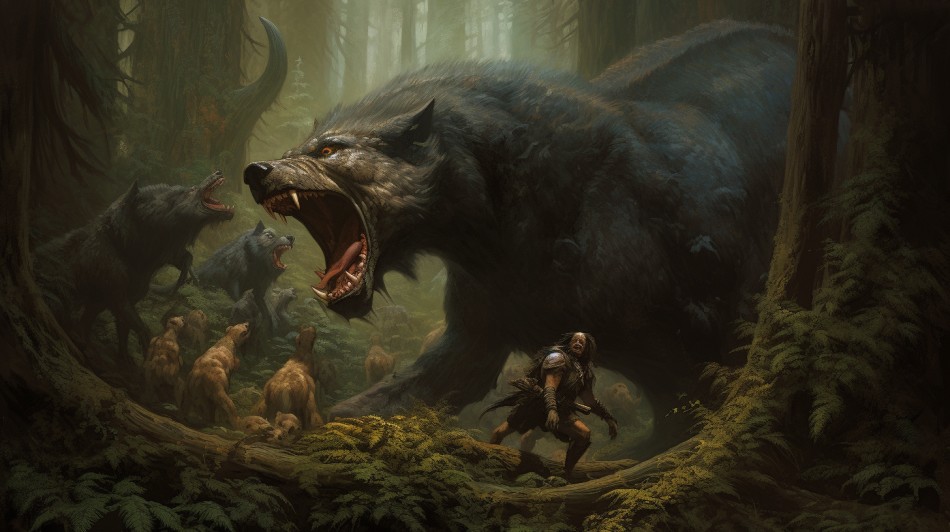
- Gargantuan Dire Wolf: Legends speak of a colossal dire wolf, surpassing the size and strength of traditional specimens. These legendary creatures possess heightened stats, making them even more formidable opponents. Additionally, their magical pelt provides resistance against spells, rendering them a true challenge to overcome. Tales whisper of their ability to teleport, adding an element of surprise to their relentless pursuit.
- Rune-Bound Dire Wolves: The rune-bound variants stand out among the enchanted dire wolves. Adorned with mystical runes covering their bodies, these creatures can tap into the power imbued within those sacred symbols. The runes grant them unique abilities, enhancing their prowess in combat and providing an unpredictable edge.
- Allied Dire Wolves: Some dire wolves have forged alliances with other magical creatures, such as werewolves. Through these pacts, they can summon assistance from their mystical allies. With a bone-chilling howl resonating with terror and bloodlust, these dire wolves inspire fear in their foes and empower their brethren, turning them into formidable adversaries.
Incorporating these variant dire wolves into your woodland encounters fills the arduous journey through the woods with epic and memorable battles. Your party will be challenged by the sheer size, magical prowess, and terrifying alliances these creatures possess.
Enemies and Dire Wolves: A Rarity in Their Ranks
While some goblin tribes utilize regular wolves as mounts, orcs and bandits employ them as guards and attackers, including dire wolves among enemy forces is a different matter. Distinguishing dire wolves from their smaller counterparts can be challenging, as these majestic creatures are relatively scarce compared to the abundant population of grey wolves.
Their innate aggression also poses difficulties in training and domestication. It is conceivable, however, that an enemy druid, sorcerer, or ranger may possess one of these rare wolves as a trusted companion or loyal pet. Nonetheless, such occurrences remain uncommon. Therefore, encountering dire wolves alongside enemy armies marching upon villages and towns is a rarity rather than the norm.

Countering Dire Wolf Tactics
Adventurers must employ clever strategies and effectively use their tools and resources to counter the tactics employed by dire wolves. Consider the following approaches:
- Ready Actions: Utilize readied actions to launch attacks as the dire wolves rush by. Timing is crucial, as striking them before they retreat to cover (and potentially employ stealth) is paramount.
- Stay Together: Keeping the group from splitting up is imperative, even if they are only a few squares apart. Dire wolves capitalize on opportunities to isolate weaker members, separating them from healing and assistance. Unity is key to survival.
- Maintain Vigilance: Avoid being caught off guard by remaining aware of your surroundings, especially during nighttime camping. Prevent the dire wolves from herding you; seek a secure location and avoid attempting to flee. If overpowering them proves challenging, intimidating the wolves may drive them away.
- Magic and Environmental Defense: Employ magic to impede the dire wolves or immobilize them, enabling the party to eliminate the threat. Additionally, non-magical tools like caltrops or a line of burning oil can serve as swift defensive measures, utilizing the environment to your advantage. Illusion magic, such as Major Image, can divert the wolves’ attention, creating distractions with visual and olfactory illusions. Exploit their preference for easier targets, redirecting their focus away from a group armed with knives and magic. However, beware that attempting to become invisible is futile, as dire wolves possess keen senses that make hiding challenging.
By employing these strategies, playing smart, and leveraging the environment to defend against the pack tactics of dire wolves, even a large pack can be overcome. Survival becomes the ultimate victory.
Running Dire Wolves for Dungeon Masters

Dire wolves possess a greater potential for danger than their CR 1 suggests, especially when employing effective strategies. Even the player counter-tactics mentioned earlier can be overcome. Here are some suggestions for running dire wolves to elevate their threat level:
Tactical Maneuvers
Emulate the behavior of real wolves by having a dire wolf rush past the party, utilizing the Dodge action to minimize the risk of being harmed. This strategic movement provokes the party’s planned attacks while increasing the likelihood of the dire wolf’s survival. Meanwhile, other dire wolves can capitalize on this distraction to attack without immediate retaliation.
Exploiting Weaknesses
For particularly challenging encounters, consider introducing vulnerabilities in dire wolves, such as sensitivity to sound due to their acute hearing or susceptibility to fire due to potentially flammable fur. Unveiling weaknesses adds depth and intrigue to the fight, allowing players to discover and exploit these vulnerabilities.
Cultural Significance
Highlight that dire wolves are not solely combatants. They can also serve as mounts within certain cultures, introducing an additional layer of complexity. Encourage players to engage with dire wolves in unique ways that evoke fear or respect from these formidable creatures. Such interactions can enrich the encounter and add depth beyond a simple skirmish.
While they may not possess the flashy abilities of fire-breathing creatures or spellcasters, Dire Wolves possess the potential to be truly terrifying in the hands of a skilled Dungeon Master.
Remember, dire wolves are imposing creatures—horse-sized wolves with powerful jaws, acute senses, and strong social bonds. While they may not possess the flashy abilities of fire-breathing creatures or spellcasters, they possess the potential to be truly terrifying in the hands of a skilled Dungeon Master.
Druids and Dire Wolf Wildshape: A Formidable Combination
One of the many strengths of druids in Dungeons and Dragons is their ability to tap into the primal forces of nature and assume the form of various animals through the Wildshape feature. Among the creatures available for transformation, the Dire Wolf is a compelling choice for druids seeking a potent combat form.
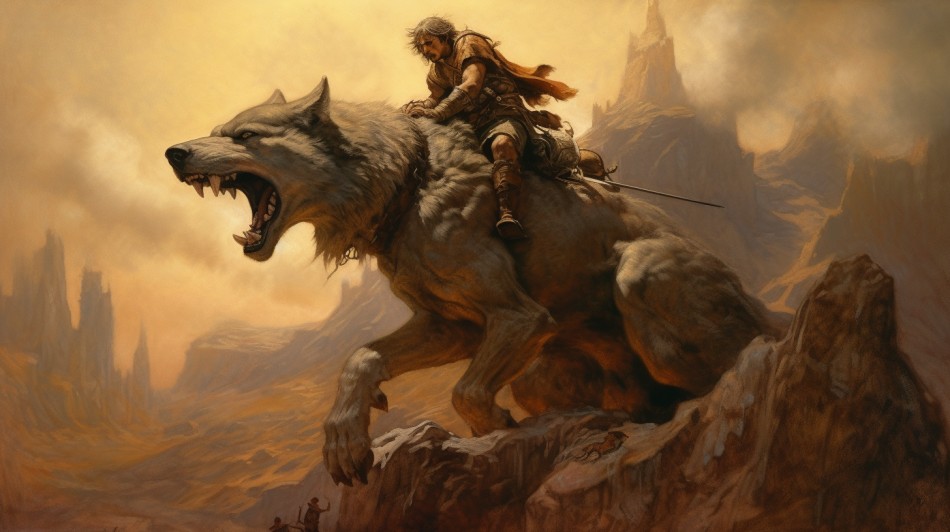
Dire Wolves possess several attributes that make them a formidable combat form for druidic wildshape:
- Sturdy and Agile: Dire Wolves boast many hit points, allowing druids to withstand significant damage in battle. Additionally, their natural armor provides a respectable Armor Class (AC), enhancing the druid’s survivability while in this form.
- Keen Senses: Dire Wolves possess Keen Hearing and Smell, granting them exceptional perception abilities. This heightened sense of smell and acute hearing can be advantageous in detecting hidden enemies or tracking elusive foes, adding versatility to a druid’s repertoire.
- Formidable Bite: The Dire Wolf’s bite delivers decent damage, allowing druids to contribute effectively to combat encounters. What sets the Dire Wolf apart is its ability to knock down opponents with its bite attack, potentially incapacitating them. The accompanying Strength saving throw further enhances the likelihood of success, giving druids an edge in controlling the battlefield.
- Pack Tactics: Pack Tactics is a feature inherent to Dire Wolves, granting them advantage on attack rolls when at least one of their allies is within 5 feet of the target. For druids who find themselves fighting alongside their companions or summoned creatures, this ability ensures reliable and accurate strikes against their adversaries.
Overall, assuming the form of a Dire Wolf through Wildshape provides druids with a solid combat option. Its durability, heightened senses, potent bite attacks, and Pack Tactics make it a reliable choice for druids seeking to engage in close-quarters combat and exert control on the battlefield.
Embrace the primal power of the Dire Wolf as a druid and unleash your ferocious nature upon your enemies.
FAQs
Q: Can a Dire Wolf be my Ally? While the official rules do not allow the dire wolf as a familiar, a DM can permit a celestial dire wolf. Rangers can have a dire wolf as an animal companion, and druids can transform into dire wolves through their wild shape ability.
Q: Can Dire Wolves Use their Claws? Dire wolves primarily rely on their powerful jaws, but claw attacks can be added to make them more formidable. However, their claw attacks should be weaker than their bite and come with certain conditions.
Q: Do Dire Wolves Fight to the Death? Dire wolves’ aggressive nature makes it a DM decision whether they fight to the death. They might flee at one-third of their hit points, showcasing their toughness and creating a memorable encounter.




